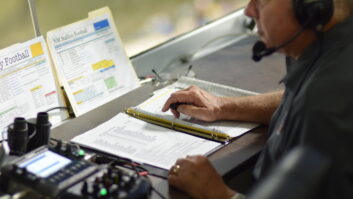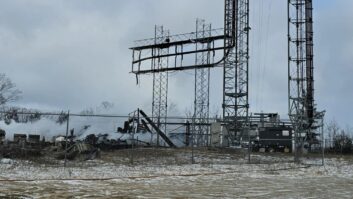
Fig. 1: An ironing board offers back support while working on the Harris 20H Series.

Fig. 2: Unracked and stacked TOC equipment awaits completion of the new Technical Operations Center. Anyone who’s been in this business for a while will find themselves scratching his or her head at the way some equipment is designed. It’s as if the designer never expected the equipment to fail.
Mark Goff handles contract engineering in Kansas and sent in a picture that’s both funny and practical.
One of his clients had a Harris FM20-H transmitter. Fig. 1 shows Mark’s high-tech approach to working on the driver tube sockets under the shelf in the 20-H. The drivers in this transmitter require a contortionist to get underneath in order to get a good view. However, the ironing board works great.
Yes, Mark found that lying on an ironing board positioned his head and arms perfectly for troubleshooting and repair of this section of the transmitter.
I must admit, I have tried lying on wooden boards and long strips of packing foam, but never thought of the ironing board.
If the uncomfortable position isn’t bad enough, engineers that have tackled this transmitter have more than likely been burned by falling solder, too. When you’re upside-down, it’s hard to get out of the way when solder splashes. I found that a wearing an inexpensive plastic swimming mask protected my eyes, and most of my face, from any falling solder.
Happily, Mark says the last “H” model in his stable of stations is gone, replaced by a new GatesAir FAX-20.
Mark also sent in a picture of an entire radio station on the floor. Shown in Fig. 2, it’s amazing what engineers sometimes have to do.
Mark was building a new technical operations center, which required all the equipment to be removed from the racks — without taking the station off the air. His solution was to unrack the gear and stack it on the floor until the construction was completed.
The station lost no appreciable airtime, and the opportunity gave Mark the ability to label and wire all the equipment properly.
****
New Hampshire Public Radio’s Steven Donnell offers an interesting means of protecting copper ground bus bars, such as that in Fig. 3.
The solution? Tin them. Steven had an instance where a site was vandalized for copper. The copper thief did not take the tinned copper bus bar used to ground all the coax grounds.
A cell site that was hit at the same time as one of Steven’s sites had three of five ground bars taken. The two that were not taken, were tinned — go figure. Steven writes that the tinned bus bars are still solid copper underneath, but if the process deters theft, consider it.
Tinned ground bus bars are available from Harger (www.harger.com) for nearly the same price as the bare copper bars.
A related New Year’s resolution is to stamp some kind of ID on the face of existing copper bus bars, as well as along the edge of the bar. Harbor Freight (www.harborfreight.com) has three alphanumeric metal stamping kits starting at under $10. Search for “metal stamp kit” on the home page.
****
Ed Dulaney, regional engineering manager for Townsquare Media in Texas and Oklahoma, saw our column on good textbooks for entry-level engineers. He says his absolute favorite is “Electronic Communication” by Robert Shrader. This was the book 30 years ago that gave Ed a lot of the theory that he still uses to this day. Ed puts it at the top of his list for anyone just starting out, and I agree. There are several editions available online.

Fig. 3: Tinned copper bus bars are avoided by copper thieves because scrap facilities don’t want them. The book includes questions and answers at the end of each chapter, to prepare for the typical FCC second- and first- class radiotelephone license tests, as well as the radar endorsement — boy, am I dating myself!
But the volume also offers a thorough discussion of tube technology, in an easy-to-understand format with plenty of drawings. I’ve loaned my copy to engineers taking the SBE certification tests, as the book is so thorough.
This was the textbook used by REI (Radio Engineering Inc.), a national FCC license prep school. Anyone remember Ray Gill?
Ed adds that any edition of the “NAB Engineering Handbook” would also be a great asset as well.
The popularWorkbench column is built around your ideas. Help fellow engineers — and qualify for SBE recertification credit while you’re at it. Send tips to [email protected]. Fax to (603) 472-4944.
Author John Bisset has spent 45 years in the broadcasting industry and is still learning. He handles West Coast sales for the Telos Alliance. He is SBE certified and is a past recipient of the SBE’s Educator of the Year Award.











